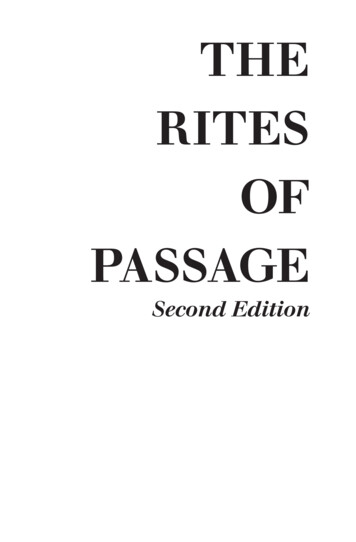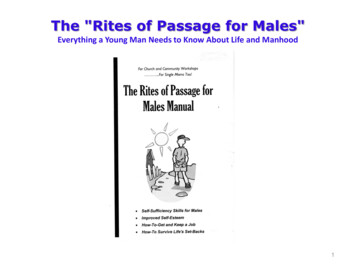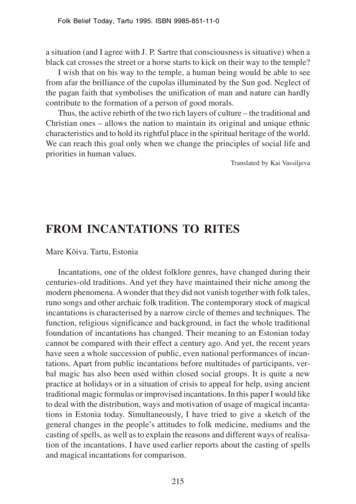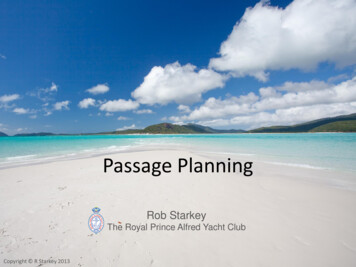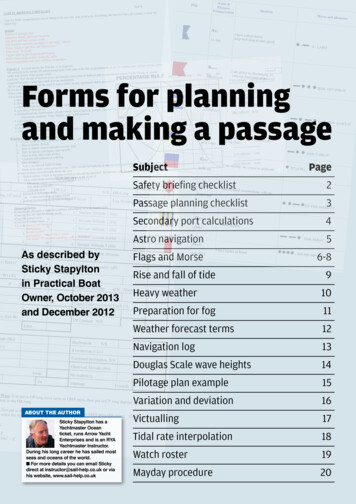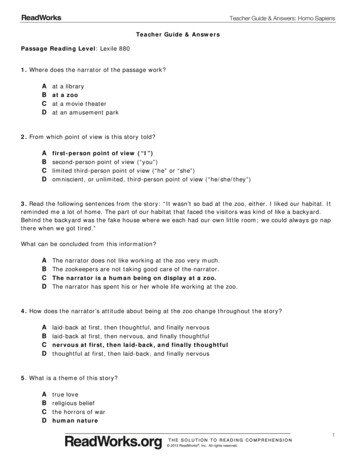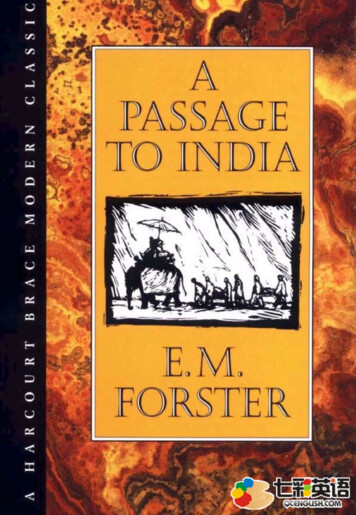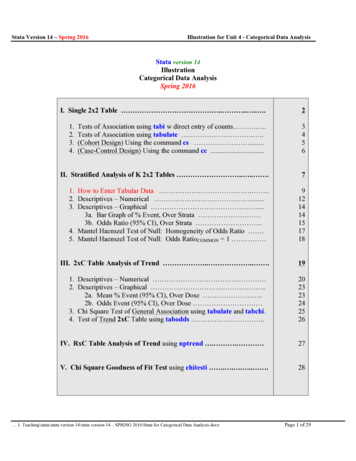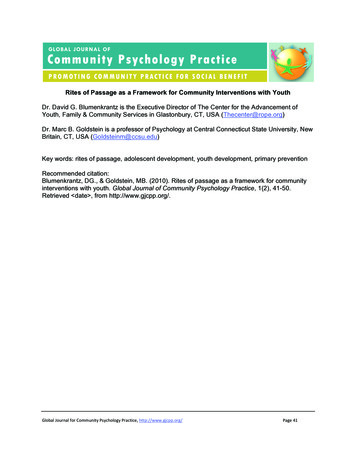
Transcription
Rites of Passage as a Framework for Community Interventions with YouthDr. David G. Blumenkrantz is the Executive Director of The Center for the Advancement ofYouth, Family & Community Services in Glastonbury, CT, USA (Thecenter@rope.org)Dr. Marc B. Goldstein is a professor of Psychology at Central Connecticut State University, NewBritain, CT, USA (Goldsteinm@ccsu.edu)Key words: rites of passage, adolescent development, youth development, primary preventionRecommended citation:Blumenkrantz, DG., & Goldstein, MB. (2010). Rites of passage as a framework for communityinterventions with youth. Global Journal of Community Psychology Practice, 1(2), 41-50.Retrieved date , from chologyPractice,http://www.gjcpp.org/Page41
acticeSeptember2010Rites of Passage as a Framework for Community Interventions with YouthDavid G. Blumenkrantz,1 Marc B. Goldstein2The Center for the Advancement of Youth, Family & Community Services,1 Central Connecticut StateUniversity2AbstractThis article discusses the potential value of adopting a rites of passage framework for developingcommunity interventions for youth and suggests principles for its application. We propose acontemporary working definition of the concept, how it could reshape the way we approach communityand youth development, and 20 core components of a rites of passage process developed from our workexperience spanning over 40 years.IntroductionThe terms “rite of passage” have become ubiquitousin contemporary society, being applied to as a diverseset of experiences as college student’s binge drinking(CASA, 1994), a first kiss or sexual experience(Carpenter, 2005), tattooing (Gillespie, 2009), and aPresident’s first war (Apple, 1989). These, andliterally thousands of similar examples may representa “first” or otherwise special experience for theindividual, a moment with meaning, but they are notnecessarily rites of passage. We believe that a rites ofpassage youth and community development strategyrepresent one of the most powerful ecological toolsavailable to community psychologists, but thatcontemporary use of this term has obscured its truemeaning and value. Our goal here is to describe whatis meant by a community-based rite of passage andhow it might be usefully applied by those who workin the community. While our focus will be on theapplication of rites of passage with youth, theprinciples can be applied to other key life transitions.Our definition of rites of passage as well as ourspecification of the structural elements that composethem comes from the lead author's experiencespanning over 40 years of practice in creatingeffective rites of passage experiences that aregrounded in the community. These experiences led tothe creation of The Center for the Advancement ofYouth, Family & Community Services, Inc. in 1990,a non-profit institute focused on “promoting positiveyouth development and [to] assist[ing] children in thetransition through adolescence to becoming healthyadults connected to their communities. Weaccomplish this by creating effective school andcommunity-based strategies in partnership withparents, teachers, counselors, and communityleaders” (ROPE, n.d.). The Center has createdROPE a multi-year intervention with communitiesthat has been used throughout the US, Canada andEurope with an estimated 100,000 youth over the past30 years. For more information on The Center,ROPE , and other related experiences, please visitwww.rope.org.What do we mean by a rite of passage?Belgian anthropologist Arnold van Gennep coinedthe term rite of passage in his seminal study(1909/1960) of patterns of behavior and customs thatvarious cultures engaged in during times of major lifetransition. What van Gennep described as rites ofpassage were community-created and communitydirected experiences that transmit cultural values andknowledge to an individual (or individuals). The riteof passage process not only guides the individual’stransition to a new status, but, equally important, itcreated public events that celebrated the transitionand reaffirmed these community values, whichinform and guide expectations for behaviors essentialfor the group’s survival. The historical record showsthat rites of passage have been present, in variousmanifestations, in all cultures for thousands of years.We would argue this suggests the strong“evolutionary validity” of these processes, whichhave remained an important part of community andcultural health promotion during the major transitionsof birth, marriage and http://www.gjcpp.org/Page42
acticeWhat happens without meaningful rites ofpassage?It could be argued that cultural rituals and secularstrategies in modern American society do noteffectively assist in our children’s transition toadulthood. The lack of clearly established rites ofpassage in America is partly due to the ambiguityabout when and how one becomes an adult incontemporary society (Arnett, 2000, 2004). The agesat which youth receive certain adult privileges (e.g.,right to drive, right to vote, right to drink, etc.) arerather arbitrary and are not related to any actualcompetencies or maturity on the part of theindividuals who gain those privileges. Thedevelopmental psychology literature providesconsiderable evidence (see Blos, 1979; Elkind, 1984;Scott, 1998) that adolescents desperately seek publicmarkers and community approbation to verify theirentry into adult status. In the absence of meaningfulcommunity-based rituals, youth will define and createtheir own marker events based on peer or mediavalues, many of which may be destructive bothindividually and communally. Indeed, this is howbinge drinking, drug use, teen pregnancy and othersimilar behaviors have become elevated to rites ofpassage reflecting adult status, e.g., CASA (1994).So what is a real rite of passage?We propose the following definition: “A modern dayrite of passage is achieved when parents and thecommunity create and participate in experienceswhich are perceived to be transformative by youthand, in fact, offer them increased status within thecommunity and facilitate their healthy transitionthrough adolescence” (Blumenkrantz, 1996, p. 21).Van Gennep (1909/1960) identified three commonfeatures in the various phenomena he labeled as ritesof passage: separation, transition (liminality) andincorporation.Separation referred to a change from the normalroutine of daily life. Historically, in the case of youth,it was often a biological marker, i.e., the onset ofpuberty. Within the family and community this wasinterpreted as a significant signal that tells a child,“From this point on you must be on a journey toadulthood. You must leave (separate from) this placeof childhood behind, separate from childish thingsand move into adulthood for the health and benefit ofyourself, your family and community.”September2010becomes lost or unclear while the initiate undergoesprecise training in values and ethics that inform andguide behavior. There are periods of extreme stress or“ordeals” that help to compel the child to experiencethe full range of human emotions and potential.From these compelling experiences, embodied in acommunity sanctioned rite of passage, the childgrows and matures and moves into the third phase,incorporation. It is at this point that he or sheincorporates these lessons into their life; they serve toguide and inform him or her of the community’sexpectation for living well and affirm them as anemerging adult ready to be integrated into the healthyfunctioning of communityAlmost all the examples of rites of passage from theanthropology literature are highly prescriptive. Theywere intended to initiate youth in small, highlyhomogeneous communities, where consensus aboutcommunity values and appropriate behaviors can beeasily established, into a rather limited number ofadult roles. It should be noted that certain culturallydefined rites of passage for youth still exist inwestern culture. Such events as Bar and Bat Mitzvahsfor observant Jews and La Quinceanera for Latinosare practiced by a small percentage of the population.The significance of such events for development hasbeen noted (see Schoenfeld 1994; Stewart, 2005). Butthese are the exceptions. Indeed, in today’s pluralisticsocieties where there are multiple possibilities forvalues and ethics that inform and guide expectationsfor behavior, one could reasonably ask: canmeaningful rites of passage be developed? Webelieve they can. The challenge for communitypsychologists is to help the communities articulatetheir shared values and develop processes and ritualsthat effectively impart these values to youth.The next section of this paper lays out some of thekey structural elements, derived from over 40 yearsof practice, which can create effective rites ofpassage experiences that are grounded in thecommunity.Characteristics of rites of passageWe have identified twenty elements that contribute toan effective, contemporary community-based rite ofpassage (see Table 1). A more thorough descriptionof all the elements can be found in a forthcomingpublication (Blumenkrantz, in preparation. Also seewww.rope.org).During this time of transition there will be a greatdeal of uncertainty and mystery that causes muchanxiety. It is a place of liminality where social http://www.gjcpp.org/Page43
acticeSeptember2010Table 1. Twenty elements of rites of passage.ComponentDefinition1. Paradigm shiftAdolescent development is connected to a community development process rather than being seensolely as an intra-psychic phenomenon. Interventions are ecological rather than individually oriented.The hallmark of a community-based rite of passage strategy is the creation of intentional, inclusivecommunity dialogues to address what are the values and expectations that youth must carry forward toinsure the future success of the community. There must be deliberate structures that allow thesecommunity discussions to occur so that some consensus about essential expectations for behavior andvalues emerge. This process must precede the creation of experiences that foster youths’understanding, appreciation and commitment to these expectations.Meaningful outcomes ultimately depend upon the quality of the relationships between youth andadults, and between the adults and the “program.” Positive outcomes only occur when people within asetting are intimately connected to the creation and/or adaptation of a strategy. It is only then that astrategy can be implemented with sufficient commitment and creativity to make it a success.If relationships are key, then those who are initiators of youth’s coming of age need training andprofessional development to build their personal awareness and resources. Individuals need to undergotheir own initiatory experience and rite of passage to aid his or her transition to maturity to be aneffective initiator of youth.Children grow up, by and large, in communities that are defined by geographic boundaries and reallive interpersonal interactions. Connection to an actual geographic place, especially when there is deepcontact with nature and a psychological sense of community is critical to a sense of self and securityfor children. Effective rites of passage establish a safe place for intentional conversations to occurbetween citizens of the community, youth and adults.Coming of age in a rites of passage experience involves creating and supporting intentionalenvironments that transmit essential values and ethics that guide and inform expectations for sociallyappropriate behaviors.Rituals represent a detailed sequence of actions that are regularly followed. Ritual, as part of the Ritesof Passage experience can set a tone and impact climate in ways that help to create a productivecontext for learning.Experiences that challenge the individual emotionally and/or physically and which presentopportunities to learn new values and/or skills.Children and youth grow up in a cacophony of sound that makes the “call to adventure,” the internalalarm clock awakening them to the coming of age process almost inaudible. Silence helps a youngperson develop an internal dialogue for narrating and making sense of what is going on around them.Stories passed down from previous generations that convey morals or cultural values.Experiences that help individuals realize and appreciate their connection and interdependence on thenatural environment.Time intentionally set aside for a person to reflect on his/her personal values, actions and beliefs.The opportunity to learn, value and appreciate one’s connection to those who went before and thevalues and ethics their heritage embraces.The opportunity to help individuals find their “bliss,” those activities that they can immerse themselvesin with great passion, and from which they receive unbridled joy.The coming of age process through rites of passage includes the giving up or giving away of someaspect, e.g., behavior, attitude, cherished item, that characterized their former status. This processconveys a reality that change – leaving something dear in the past behind – is an integral part of thetransition.The use of sanctioned behaviors such as vision quest, meditation, yoga, movement and dance, play in‘in the zone’ with sports and hobbies to experience non-ordinary states of reality.Through the initiatory process, adolescents are oriented to recognize that service to the community isan essential part of becoming a fully functioning adult in ingpublicritesofpassage.Opportunities for particip
27.08.2010 · passage in America is partly due to the ambiguity about when and how one becomes an adult in contemporary society (Arnett, 2000, 2004). The ages at which youth receive certain adult privileges (e.g., right to drive, right to vote, right to drink, etc.) are rather arbitrary and are not related to any actual competencies or maturity on the part of the individuals who gain those privileges. The .
